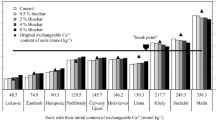Abstract
Chemical analyses for major ions have been conducted on waters,collected on an approximately weekly basis over the period April, 1993 toNovember, 1996, that drain three small experimental ecosystems(“sandboxes”) at Hubbard Brook, New Hampshire. One sandbox is planted withpine trees, another with grass, and the third is left “bare” (actually itis covered sporadically by bryophytes and lichens). Results show linearcorrelations, independent of discharge, between the concentrations ofdissolved Na+ and K+ on the one hand andCa++ and Mg++ on the other for all threesandboxes. No correlations between singly charged and doubly chargedcations were found. These correlations are interpreted to represent cationexchange equilibria between soil waters and clay minerals plus soil organicmatter. The correlation slope, representing the exchange constant, for Na vsK is different for the pine-covered sandbox than for the other two whereasfor Ca vs Mg the correlation is independent of the presence or absence oftrees. We interpret this as representing a shift of cation exchangeequilibria in the pine sandbox by the activities of growing trees.
Concentrations of Na, K, Ca, Mg, and H4SiO4from the barren and grass-lined sandboxes were found to vary seasonally witha marked sinusoidal pattern which was independent of the discharge from eachsandbox. (The discernment of a similar pattern in the tree lined sandbox wasdifficult due to a lack of discharge over much of the year.) Concentrationmaxima occurred in August and minima in February, and there is a closeparallelism with soil temperature. We interpret this as representingtemperature induced variations in cation exchange equilibria and silicaadsorption. Independence from highly varying water discharge, e.g.,. thataccompanying severe rainstorms, indicates rapidly re-attained equilibrium.Variations in the concentrations of cations are likely due to exchange withunmeasured cations, probably H+ or dissolved Al species, as aresult of possible seasonal changes in internal acid production and externalinput of acid rain to the sandboxes. Internal production may represent aresponse to seasonal changes in respiration rate as it responds toseasonally varying temperature. Added to this is the effect of temperatureon exchange equilibrium. Seasonal variations in dissolved silica are mostlikely due to the dependence of adsorption/desorption equilibria ontemperature. The temperature dependence of a number of silica-consumingreactions are consistent with the measured values.
Similar content being viewed by others
References
Berner, E. K. and Berner, R. A. (1996) Global Environment: Water, Air and Geochemical Cycles.Prentice-Hall, Upper Saddle River, NJ.
Berner, R. A and Rao, J.-L. (1997) Alkalinity buildup during silicate weathering under a snow cover. Aquatic Geochem. 2, 301-312.
Bischoff, J. L., Greer, R. E., and Luistro, A. O. (1970) Composition of interstitial waters of marine sediments: temperature of squeezing effect. Science 167, 1245-1246.
Bormann, F. H., Bowden, W. B., Pierce, R. S., Hamburg, S. P., Voigt, G.K., Ingersoll, R. C., and Likens, G. E. (1987) The Hubbard Brook sandbox experiment. In Restoration Ecology(ed. R. Jordan et al.), pp. 251-256. Cambridge University Press.
Bormann, B. T., Wang, D., Bormann, F. H., Benoit, G., April, R., and Snyder, M. C. (1998) Rapid plant induced weathering and soil development in an experimental pine system. Biogeochemistry(in press).
Chapman, P. J, Reynolds, B., and Wheater, H. S. (1995) The seasonal variation in soil water and neutralizing capacity in peaty podzols in Mid-Wales. Water, Air and Soil Pollution 85, 1089-1094.
Drever, J. I. (1997) The Geochemistry of Natural Waters. 3rd ed. Prentice-Hall, Upper Saddle River, NJ.
Giusti, L. and Neal, C. (1993) Hydrological pathways and solute chemistry of storm runoff at Dargall Lane, southwest Scotland. J. Hydrology 142, 1-27.
Johnson, N.M., Driscoll, C. T., Eaton, J. S., Likens, G. E., and McDowell, W. H. (1981) “Acid rain”, dissolved aluminum and chemical weathering at the Hubbard Brook Experimental Forest, New Hampshire. Geochim. Cosmochim. Acta 45, 1421–1437.
Kirchner, J. W., Dillon, P. J., and LaZerte, B. D. (1992) Predicted response of stream chemistry to acid loading tested in Canadian catchments. Nature 358, 478-482.
Kram. P., Hruska, J., Wenner, B. S., Driscoll, C. T., and Johnson, C.E. (1997) The biogeochemistry of basic cations in two forest catchments with contrasting lithology in the Czech Republic. Biogeochemistry 37, 173-202.
Lasaga, A. C. (1998) Geochemical Kinetics. Princeton University. Press (in press)
Likens, G. E., Driscoll, C. T., and Buso, D. C. (1996) Long-term effects of acid rain: response and recovery of a forest ecosystem. Science 272, 244-246.
Lee, Y. H., Hultberg, H., Sverdrup, H., and Borg, G. C. (1995) Are ion exchange processes important in controlling the cation chemistry of soil and runoff waters. Water, Air and Soil Pollution 85, 1819-1824.
Neal, C. and Robson, A. J. (1994) Integrating soil water chemistry variations at the catchment level within a cation exchange model. Sci. of the Total Environ. 144, 93-102.
Pinol, J., Avila, A., and Roda, F. (1992) The seasonal variation of stream water chemistry in forested Mediterranean catchments. J. Hydology. 140, 119-141.
Reuss, J. O. (1983) Implication of the calcium-aluminum exchange system for the effect of acid precipitation on soils. J. Environ. Qual. 12, 591-595.
Rice, K. C. and Bricker, O. P (1995) Seasonal cycles of dissolved constituents in steamwater in two forested catchments in the mid-Atlantic region of the eastern USA. J. Hydrology 170, 137-158.
Sogn, T. A. (1993) A test of chemical equilibrium equations and assumptions commonly used in soil-oriented charge balance models for soil and freshwater acidification. Ecological Modeling 70, 221-238.
Sposito, G. (1984) The Surface Chemistry of Soils.Clarendon Press, Oxford.
White, A. F. and Brantley, S. L. (1995) Chemical weathering of the silicate minerals. Min. Soc. Am. Rev. in Mineralogy 31.
Author information
Authors and Affiliations
Rights and permissions
About this article
Cite this article
Berner, R.a., Rao, JL., Chang, S. et al. Seasonal Variability of Adsorption and Exchange Equilibria in Soil Waters. Aquatic Geochemistry 4, 273–290 (1998). https://doi.org/10.1023/A:1009680430757
Issue Date:
DOI: https://doi.org/10.1023/A:1009680430757




